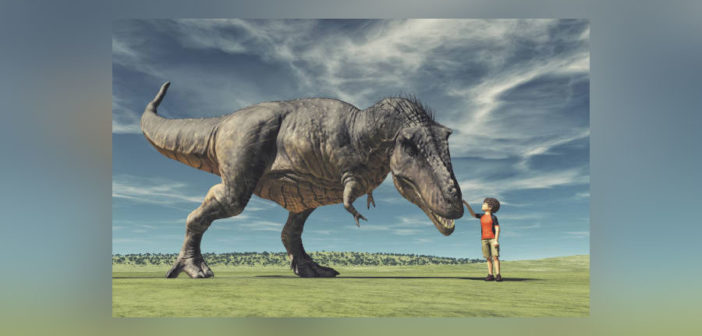Redefining & embracing the presence of established brands
Startups are driving innovation. They’re the best places to work. They’re youthful and energetic. They’re where all the money is now.
These are the kinds of messages that bombard the corporate world in this era of tech startup worship. Large, established companies are called “dinosaurs” because they’re so big and so slow that they make themselves extinct. That’s the conventional wisdom, at least.
Do you work at a dinosaur? Have you successfully built an enduring brand? Are you the establishment? Congratulations. Embrace it. You should be thankful every single day that you’re a dinosaur. It’s time to redefine what a dinosaur means. Here’s why dinosaurs rule the Earth:
1) Everyone loves dinosaurs. Since before an age when most girls and boys can even say the word “dinosaur,” kids are crazy about them. For many if not most kids, that sense of wonder doesn’t go away.
The same is true for brands. Almost every startup wants to become a dinosaur because that means they’re a household name, at least in their category. In the tech trades, startups seek to achieve “unicorn” status, meaning they gain a valuation of at least $1 billion. Startups aren’t usually focused on taking down other startups; they want to go after the dinosaurs. Who do you compete with? The ones you have the most respect for.
2) Dinosaurs come in all sizes. Some of them were as small as chihuahuas. If you remember the tiny ‘compies’ (procompsognathus) from the “Jurassic Park” sequel “The Lost World,” they were adorable, even if deadly. They defy what most people think of when imagining dinosaurs.
Brands also come in all sizes and shapes. Some brands are as monstrously sized as titanosaurs, but there is such a wide range in terms of what brands do, how they thrive and survive, and what it’s like to work for them. Also, so much success derives from the people there. Marketing executives from wildly different brands may have much more in common with each other than their direct competitors. So many marketing leaders and pioneers come from unexpected brands and categories. Anytime someone says “brands don’t get it,” the only thing that seems certain is that the speaker doesn’t know what he or she is talking about.
3) Dinsosaurs didn’t make themselves extinct. There’s a Far Side cartoon by Gary Larson showing dinosaurs smoking cigarettes with the caption, “The real reason dinosaurs became extinct.” No, dinosaurs became extinct due to some massive planetary change in climate and livability that they had no control over. Dinosaurs still managed to stick around for 170 million years. Humans have been around for a few hundred thousand years.
Brands, too, aren’t always making themselves extinct. Most successful brands continue to release new offerings and adapt to the market as decades pass, but given that such companies were initially created for a different climate, adaptation is hardly a given. Startups don’t have that pressure as they are created for a very specific time and place, in an era where communication channels and globalization allow for more rapid scaling. Yes, some older companies need to change their entire business models, and many of them do. Still, many that don’t still won’t be disrupted if they have an offering that their buyers want and can’t easily get from a replacement. Even for those that become extinct, becoming a dinosaur in the first place means they probably had an impressive run – and a longer run than most startups experience.
4) Dinosaurs are still here. Birds are dinosaurs’ heirs, while creatures like alligators and crocodiles give us a visceral taste of what they must have been like. Beyond that, dinosaurs shape our culture to this day, whether they’re used as business metaphors or box office stalwarts. “Jurassic World: Fallen Kingdom” had the same plot as all of its predecessors with even more predictability, and it still earned $1.3 billion globally. Meanwhile, visit any bookstore with a good children’s section, and you’ll find a section devoted entirely to dinosaurs.
Brands don’t go away easily. Once brands get some cachet, consumers will get nostalgic for practically anything – brands their parents liked, brands their grandparents liked, or brands that were trendy ten years ago and faded away quickly. Established business-to-business brands also make buyers feel safe in sticking with a time-tasted choice. Even many dinosaurs that struggle to adapt have a long enough runway to regroup, learn from failed approaches, and find that right product-market fit.
5) Dinosaurs are real. Unicorns are imaginary. The biggest difference between dinosaurs and unicorns is that we know that millions and millions of dinosaurs roamed the Earth. They had to struggle to survive as they constantly evolved and morphed to meet new demands. Unicorns, however, are the stuff of legend.
Given that they’re mythical, unicorns don’t have the same challenges of, say, profitability. They might have to answer to a board of directors and venture capitalists, but they don’t have the same pressures to deliver tangible results. In the technology vertical, we tend to mythologize the role of the biggest companies and look the other way when they don’t return profits or don’t pay taxes. Dinosaurs, by being more substantive, have real challenges, like whether they’ll stay alive after the continental drift breaks up their home. It might be fun to be a unicorn, but sometimes you can’t flap your wings, shoot glittery fairy dust out of your horn, and make everything look alright.
Survival is messy. Evolving is hard. When the continents drift, bet on the dinosaur over the unicorn to still be alive when it’s done. Sure, they may go extinct, but not for a long time coming.
–
This article first appeared in www.marketingmagnified.com
Seeking to build and grow your brand using the force of consumer insight, strategic foresight, creative disruption and technology prowess? Talk to us at +9714 3867728 or mail: info@groupisd.com or visit www.groupisd.com


